S3IPBio_Notes_Movement of Substances
Nanyang Girls’ High School 
2023 Sec 3 IP Biology Notes
Name: ( ) Class:
TOPIC: MOVEMENT OF SUBSTANCES
Content Outline:
1. Structure of Cell membrane
• Fluid Mosaic Model
• Components of Cell membrane
2. Function of Cell membrane
3. Transport of substances across cell membrane
• Passive transport
o Simple diffusion
o Facilitated diffusion
o Osmosis and cells in solution
• Active transport
• Bulk transport
Learning Outcomes:
By the end of the chapter, you should be able to:
O Levels Biology Syllabus 6093 Learning Outcomes
a) define diffusion and describe its role in nutrient uptake and gaseous exchange in plants and humans
b) define osmosis and describe the effects of osmosis on plant and animal tissues c) define active transport and discuss its importance as an energy-consuming process by which substances are transported against a concentration gradient, as in ion uptake by root hairs and uptake of glucose by cells in the villi
NYGH IP Learning Outcomes
d) Relate the structure of the cell membrane to the functions of the cell membrane. e) Describe briefly the Fluid Mosaic Model of cell membrane.
f) Explain why it is important to consider surface area to volume ratio to speed up diffusion rather than an increase in surface area only.
g) Explain plasmolysis and turgidity of plant cell and crenation and lysis of animal cell in relation to the cell’s environment.
h) Describe the importance of water potential gradient in the uptake of water by plants and the effects of osmosis on animal tissue.
i) Describe how facilitated diffusion is carried out across the cell membrane.
S3 IP Biology Notes Movement of Substances 1
j) Outline the entry of glucose from lumen to ileum epithelial cells by active transport and then from epithelial cells to blood capillary in villus by facilitated diffusion.
k) Define, compare, and contrast endocytosis and exocytosis.
Use the knowledge gained in this section in new situations or to solve related problems.
1 Structure of Cell membrane
Cell membranes are found on the surface of all living cells and membrane-bound organelles in eukaryotic cells such as the nucleus, mitochondria, chloroplasts, vesicles, vacuoles, Golgi apparatus and the endoplasmic reticulum.
1.1 Fluid Mosaic Model
• In 1925, Gorter and Grandel concluded that cells were surrounded by a lipid bilayer. • In 1935, Danielli and Davson suggested that lipid bilayer was sandwiched between two thin protein layers and this theory dominated cell membrane studies for subsequent 30 years, partly due to the lack of molecular techniques.
• In 1972, Singer and Nicolson proposed a fluid mosaic model for the structure of biological membranes. This model was supported by evidence from different research done by other scientists.
Fluid: Phospholipid molecules move freely and laterally within the phospholipid bilayer. 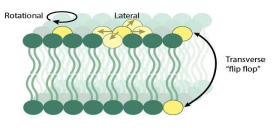
Figure: Fluidity of phospholipids in a membrane
Mosaic: Different proteins are randomly embedded and scattered among the phospholipids. 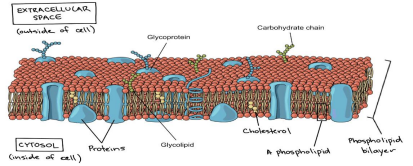 Figure: Mosaic nature of phospholipid arrangement in a membrane
Figure: Mosaic nature of phospholipid arrangement in a membrane
S3 IP Biology Notes Movement of Substances 2
1.2 Components of the Cell membrane
A. Phospholipids
Structure
• Phospholipids are amphipathic due to their distinct hydrophilic and hydrophobic properties.
• A phospholipid molecule consists of a hydrophilic phosphate group attached to the glycerol molecule and 2 hydrophobic fatty acid chains / tails.
• They are arranged as a bilayer in all membrane structures of the cell.
• The hydrophilic phosphate heads face outwards into the aqueous cytoplasm and aqueous extracellular space.
• The hydrophobic fatty acid chains / tails face each other in the middle of the bilayer to form the hydrophobic core.
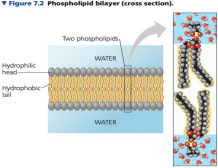
 Function
Function
• The bilayer arrangement of the phospholipids forms a barrier between the aqueous environment and the cell cytoplasm.
B. Proteins
Structure of membrane proteins
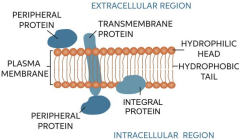
● Structure of Extrinsic / Peripheral Proteins
o Extrinsic proteins are loosely bound to the membrane surface and are exposed to the aqueous medium of extracellular fluid and cytoplasm.
o They do not penetrate the membrane.
o They are proteins found on either side of the bilayer.
S3 IP Biology Notes Movement of Substances 3
● Structure of Intrinsic / Integral Proteins
o Intrinsic proteins are embedded in the hydrophobic core of phospholipid bilayer. o Transmembrane proteins are embedded in they phospholipid bilayer. o They contain both hydrophobic and hydrophilic regions.
Function of membrane proteins


(a) Channel proteins have hydrophilic channels which transport specific hydrophilic substances (e.g., ions) across membranes.
(b) Carrier proteins have binding sites which bind and transport specific substances across the membrane
o down their concentration gradient (facilitated diffusion) or
o against their concentration gradient using energy released to pump substances across (active transport).
*Carrier proteins use energy to pump substances across are called protein pumps. *Aquaporins are membrane channels that transport water molecules.
C. Glycoproteins and glycolipids
Structure
● Glycoproteins: Proteins with addition of short carbohydrate chains / residues. ● Glycolipids: Phospholipids with addition of short carbohydrate chains / residues.
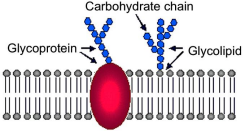
Function
● Cell-cell recognition: cells can recognise and bind to one another e.g., the recognition of bacteria by white blood cells.
● Cell-cell adhesion: two adjacent cells may bind with each other, enabling cells to form a tissue.
● Receptors: to bind to molecules for cell signaling e.g., insulin bind to receptors found on liver and muscle cells, signaling the cells to convert excess glucose into glycogen for storage in the cells.
S3 IP Biology Notes Movement of Substances 4
D. Cholesterol 
Structure
● Cholesterols are interspersed within the bilayer.
Function
● Cholesterols help to regulate fluidity of cell
membrane in animal cells.
● At low temperatures, cholesterol disturbs the close packing of phospholipids and keeps them more fluid.
o This is important for organisms living at low temperatures where membranes tend to solidify as cholesterol prevents the membrane from freezing.
● At high temperatures (>350C), phospholipids tend to gain kinetic energy and move further apart from each other.
o Cholesterol makes the membranes less fluid by restraining the movements of phospholipids, preventing the membrane from breaking apart.

2 Function of Cell membrane
(i) Boundary
● The cell surface membrane forms a boundary that separates the cell contents from the external extracellular environment.
● This allows the internal cytoplasm environment of the cell to be kept relatively constant in order to function optimally.
(ii) Compartmentalisation
● Internal cell membranes of organelles enable compartmentalisation of cell contents and prevent mixing.
● This allows for specialisation of cell function by concentrating specific substances (e.g., enzymes and chemicals) needed for metabolic processes.
● E.g., lysosomes contain enzymes that destroy bacteria but not other contents.
(iii) Selectively Permeable Barrier
● Cell membranes are selectively permeable to prevent interchange of substances. ● Hydrophobic and lipid-soluble substances (e.g., oxygen and carbon dioxide) can diffuse through the hydrophobic core of phospholipid bilayer.
● Hydrophilic substances (e.g., ions, glucose, amino acids) are repelled by hydrophobic fatty acid tails in the hydrophobic core of phospholipid bilayer. ● Close packing of phospholipids further prevents larger-sized substances (e.g., glucose, amino acids) from moving through.
S3 IP Biology Notes Movement of Substances 5
3 Transport of substances across Membrane
The process by which a substance is transported across the membrane largely depends on the property of the substance – hydrophilic or hydrophobic
● Hydrophobic substances
o Hydrophobic substances (e.g., oxygen, carbon dioxide) are not able to form favourable interactions with water molecules and thus can diffuse easily through the hydrophobic core of the cell membrane
o Hydrophobic substances are considered lipid-soluble i.e., able to form favourable interactions with hydrophobic fatty acid tails of the phospholipid bilayer.
● Hydrophilic substances
o Hydrophilic substances (e.g., ions, glucose, amino acids) can form favourable interactions with water molecules and thus cannot diffuse easily through the hydrophobic core of the cell membrane.
o Hydrophilic substances require transport proteins to move across the phospholipid bilayer, as these substances are repelled by hydrophobic fatty acid tails in the hydrophobic core.
o Larger-sized substances (e.g., glucose and amino acids) are also not able to move through easily due to close packing of phospholipids.
There are 3 main processes of transport:
Passive Transport, Active Transport and Bulk Transport.
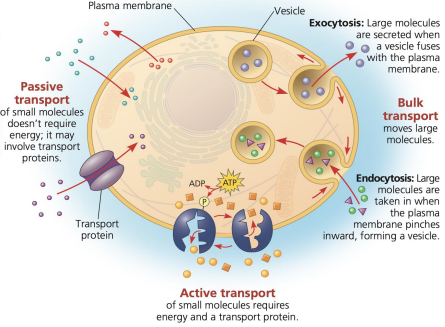 Figure: 3 types of membrane transport processes – Passive, active and bulk transport
Figure: 3 types of membrane transport processes – Passive, active and bulk transport
S3 IP Biology Notes Movement of Substances 6
3.1 Passive transport
• Passive transport is the movement of substances down a concentration gradient without the use of energy. There are 3 types of passive transport:
(i) Simple Diffusion
• Simple diffusion refers to the net movement of substances down concentration gradient from region of higher concentration to region of lower concentration. • Hydrophobic substances: oxygen, carbon dioxide, and some hormones move across the phospholipid bilayer by simple diffusion.
Factors affecting rate of simple diffusion:
• Molecular mass: lower molecular mass results in faster diffusion.
• Temperature: higher temperature leads to higher kinetic energy of molecules for faster diffusion.
• Concentration gradient: the steeper the concentration gradient, the higher the diffusion rate.
• Distance: shorter the distance, the higher the diffusion rate.
• Surface area to volume ratio: greater the surface area to volume ratio, higher the diffusion rate.
(ii) Facilitated Diffusion
● Facilitated diffusion is the net movement of substances down a concentration gradient from a region of higher concentration to a region of lower concentration with the aid of transport proteins across a selectively permeable membrane.
● Hydrophilic substances move across the phospholipid bilayer by facilitated diffusion include ions, glucose, amino acids.
● Facilitated diffusion is a passive process, which does not require energy as particles move down a concentration gradient.
● Diffusion is facilitated by transport proteins:
o Channel proteins have hydrophilic channels which transport specific hydrophilic substances (e.g. chloride ions) across membranes.
o Carrier proteins have binding sites which bind and transport specific substances across membrane.
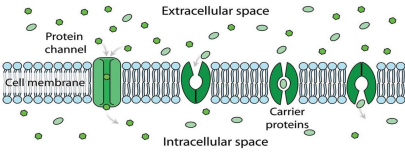 Figure: Facilitated diffusion across membranes via ion channels and carrier proteins
Figure: Facilitated diffusion across membranes via ion channels and carrier proteins
S3 IP Biology Notes Movement of Substances 7
(iii) Osmosis
● Osmosis is the net movement of water molecules down a water potential gradient from a region of less negative water potential to a region of more negative water potential across a selectively permeable membrane.
● Osmosis is a passive process, which does not require energy. ● Equilibrium is reached when there is no net movement of water molecules; water molecules are uniformly distributed at equilibrium.
● Water molecules pass through the membrane with the aid of channel proteins called aquaporins.
(Less negative water potential)
(More negative water potential)
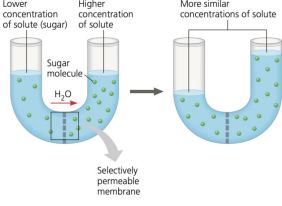
Figure: Movement of water within a U-tube apparatus setup via osmosis
● Water potential is a measure of the tendency of water molecules to move from one place to another.
o Pure water has water potential value of zero
o Water potential of a solution becomes more negative
● A water potential gradient is established when a selectively permeable membrane separates two solutions of different water potentials.
● Water molecules tend to move from a region of a less negative water potential to a region of more negative water potential.
● A selectively permeable membrane is required e.g., cell membrane, tonoplast. 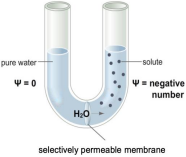
S3 IP Biology Notes Movement of Substances 8
Cells in solution
There are 3 possible relative concentrations of solutions surrounding cells:
● Isotonic solution: has the same water potential as the cytoplasm. Hence, no net water molecule movement by osmosis across a selectively permeable membrane. ● Hypertonic solution: has a more negative water potential compared to the cytoplasm. Hence, net water molecules movement from cytoplasm into solution by osmosis across a selectively permeable membrane
● Hypotonic solution: has a less negative water potential compared to the cytoplasm. Hence, net water molecule movement from solution into cytoplasm by osmosis across a selectively permeable membrane.
Isotonic solution | Hypertonic solution | Hypotonic solution |
|---|---|---|
water potential between cell and surrounding solution is the same | water potential of solution is more negative than water potential of cytoplasm of animal cell / cell sap of plant | water potential of solution is less negative than water potential of cytoplasm of animal cell / cell sap of plant |
Osmosis does not occur | Osmosis occurs | Osmosis occurs |
no net movement of water molecules | net movement of water molecules from cytoplasm of the animal cell / cell sap of the plant cell into surrounding solution across a partially permeable membrane by osmosis | net movement of water molecules from surrounding solution into the cytoplasm of the animal / cell sap of the plant cell across a partially permeable membrane by osmosis |
animal cell remains the same size and shape | animal cell shrinks and crenate | animal cell will swell and burst/lyse, due to absence of cell wall |
plant cell remains the same size and shape (may be slightly flaccid) | plant cell will become plasmolysis, where the plasma membrane pulls away from cell wall | plant cell will increase in size and become turgid, cell wall provides mechanical support and prevents bursting of cell |
S3 IP Biology Notes Movement of Substances 9
Turgor pressure
● Turgor pressure is the pressure exerted by the cell wall against the contents of the plant cell. A plant cell is turgid when large numbers of water molecules enter the plant cell via osmosis.
● High turgor pressure in plant cells enables the plant to maintain its shape and to remain firm and turgid, this prevents wilting in plants.
Figure: How red blood cells would be affected in solutions with varying water potentials
Table: Comparison of diffusion and osmosis
Diffusion | Osmosis | |
|---|---|---|
Similarities | ● both are passive processes that do not require energy ● requires two regions with different concentrations ● particles move down a concentration gradient | |
Molecules involved | all types of particles can undergo diffusion | only water molecules are involved in osmosis |
Selectively permeable membrane | does not require a selectively permeable membrane, but can still occur in the presence of one | requires the presence of a selectively permeable membrane |
S3 IP Biology Notes Movement of Substances 10
Table: Comparison of simple and facilitated diffusion
Simple diffusion | Facilitated diffusion | |
|---|---|---|
similarities | ● both are passive processes that do not require energy requires two regions with different concentrations ● molecules move across cell membrane down a concentration gradient | |
Involvement of transport proteins | particles diffuse directly across phospholipid bilayer | requires the aid of transport proteins |
Particles involved | • Oxygen, carbon dioxide • water (osmosis), glycerol hydrocarbons | ions, amino acids, sugars, water-soluble substances (polar molecules) |
Table: Comparison of active transport and facilitated diffusion
Active transport | Facilitated diffusion | |
|---|---|---|
similarities | ● requires two regions with different concentrations ● molecules move across cell membrane ● protein transporters are involved | |
Energy requirements | Energy required | Passive process that does not require energy |
Examples | ● absorption of mineral salts from surrounding solution in soil into root ● hair cells absorption of glucose from lumen into small intestine epithelial cells | ● ions, amino acids, sugars, water-soluble substances moving across cell membranes ● glucose molecules enter liver cells via facilitated diffusion to maintain constant blood glucose levels |
S3 IP Biology Notes Movement of Substances 11
3.2 Active transport
● Active transport is the movement of substances against a concentration gradient, using metabolic energy, i.e., from a region of lower concentration to a region of higher concentration across a selectively permeable membrane.
● Protein pumps have binding sites which bind and transport specific substances across membrane.
![]() Figure: Steps involved during active transport via protein pumps
Figure: Steps involved during active transport via protein pumps
Example: absorption of ions by root hair cells in plants
Water molecules by osmosis ![]()
Mineral salts by active transport
Figure: Diagram of root hair cell
o Root hair cells are specialised plant cells adapted to carry out absorption of water and mineral salts.
o The solution in the soil has a lower concentration of mineral salts and a less negative water potential than the cell sap of the root hair cell.
o Water molecules are absorbed into the root hair cells via osmosis, where water molecules move from a region of less negative water potential (surrounding solution in soil) to a region of more negative water potential (cell sap of root hair cell), across selectively permeable membranes (cell membrane and tonoplast).
o Mineral salts (ions) are absorbed via active transport, where mineral salts move from a region of lower concentration (surrounding solution in soil) to a region of higher concentration (cell sap of root hair cell), which requires energy.
S3 IP Biology Notes Movement of Substances 12
3.3 Bulk transport
● This process of transport is used to transport very large substances e.g., proteins ● Energy released from mitochondria is required.
● Endocytosis and exocytosis keep the amount of cell membrane relatively constant in non-growing cells, by allowing the addition and loss of membranes to be approximately equal.
Figure: Endocytosis vs exocytosis
(a) Endocytosis
● Endocytosis involves an invagination of cell surface membrane (i.e., pseudopodia formation) to transport very large substances into the cell.
● An endosome (specialised vesicle from endocytosis) containing the substance is formed after pinching/budding off from the cell surface membrane.
There are different types of endocytosis depending on the material taken up: ![]() Figure: 3 types of endocytosis
Figure: 3 types of endocytosis
S3 IP Biology Notes Movement of Substances 13
(b) Exocytosis
● Exocytosis involves transport of very large substances (e.g., undigested materials, proteins* like enzymes, and some hormones) out of cell.
![]() Figure: Processes and molecules involved in exocytosis
Figure: Processes and molecules involved in exocytosis
Table: Comparison of exocytosis and endocytosis
Exocytosis | Endocytosis | |
|---|---|---|
Similarities | • bulk transport of substances across membranes • energy is required • vesicles and cell membrane are involved | |
Direction of movement of substances | Exit the cell | Enter the cell |
Vesicles | vesicles fuse with cell membrane | vesicles form from the cell membrane |
Examples | secretion of substances like enzymes or hormones out of secretory cells | phagocytosis, pinocytosis, receptor mediated endocytosis |
S3 IP Biology Notes Movement of Substances 14
 Knowt
Knowt